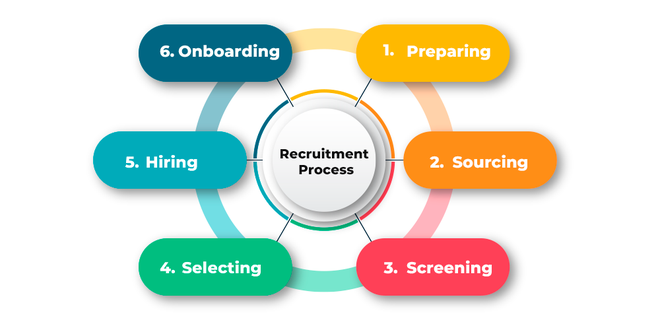Recruitment stands as the cornerstone of any organization’s success. It’s the process through which businesses identify, attract, and hire the most qualified candidates for various roles within their structure. In today’s competitive era, understanding the fundamental characteristics and features of recruitment is paramount for businesses aiming to thrive. Let’s delve into the intricate world of recruitment and uncover its core features that pave the way for successful talent acquisition.

- Strategic Planning
At the heart of effective recruitment lies strategic planning. Before initiating the hiring process, organizations must outline their objectives, analyze workforce requirements, and forecast future needs. Strategic planning enables businesses to align recruitment efforts with overarching goals, ensuring that each hire contributes to the company’s long-term success. By strategically planning recruitment initiatives, companies can anticipate talent gaps and proactively address them, thus fostering a robust and sustainable workforce.
- Targeted Sourcing
Gone are the days of posting job listings and hoping for the best. Modern features of recruitment rely on targeted sourcing techniques to identify and engage top talent. Whether through social media platforms, professional networking sites, or specialized job boards, recruiters leverage diverse channels to reach qualified candidates. By targeting specific demographics, skill sets, and industries, organizations can streamline the recruitment process and connect with individuals who possess the desired qualifications and cultural fit.
- Employer Branding
In today’s competitive job market, employer branding plays a pivotal role in attracting and retaining top talent. A strong employer brand not only enhances the organization’s reputation but also serves as a magnet for prospective candidates. Through compelling storytelling, showcasing company culture, and highlighting employee experiences, businesses can differentiate themselves from competitors and become employers of choice. By investing in employer branding initiatives, companies can create a compelling narrative that resonates with candidates and fosters a sense of belonging.
- Candidate Experience
The candidate experience encompasses every interaction a prospective employee has with the organization, from initial contact to onboarding and beyond. A positive candidate experience can significantly impact the features of recruitment outcomes, influencing candidates’ perceptions of the company and their decision to accept an offer. To enhance the candidate experience, organizations should prioritize transparency, communication, and responsiveness throughout the hiring process. By providing timely feedback, addressing concerns, and offering a seamless onboarding experience, businesses can leave a lasting impression on candidates and cultivate a talent pipeline for future roles.
- Data-Driven Insights
In the digital age, data serves as a powerful tool for optimizing recruitment strategies and driving informed decision-making. By leveraging data analytics and metrics, organizations can gain valuable insights into various aspects of the recruitment process, including sourcing effectiveness, candidate engagement, and time-to-hire. Data-driven recruitment enables businesses to identify trends, identify areas for improvement, and refine their approach to talent acquisition continuously. Whether through applicant tracking systems, recruitment software, or predictive analytics, harnessing data empowers organizations to make strategic recruitment decisions that yield tangible results.
- Diversity and Inclusion
Incorporating diversity and inclusion features into recruitment strategies goes beyond mere buzzwords; they are foundational elements crucial for success. Embracing these features fosters innovation, boosts employee engagement, and bolsters organizational performance. To integrate diversity and inclusion features into recruitment, organizations must implement inclusive hiring practices, eradicate bias from selection processes, and actively pursue candidates from underrepresented backgrounds. By embracing these features of recruitment, businesses can access a wider talent pool, harness diverse perspectives, and foster a more dynamic and inclusive workplace culture.
- Continuous Improvement
Recruitment is an iterative process that requires constant evaluation and refinement. By embracing a culture of continuous improvement, organizations can adapt to evolving market trends, technological advancements, and shifting candidate expectations. Regularly soliciting feedback from stakeholders, conducting post-mortem analyses of recruitment campaigns, and benchmarking against industry best practices enable businesses to identify areas for enhancement and drive innovation in talent acquisition. By prioritizing continuous improvement, organizations can stay ahead of the curve and remain competitive in the ever-changing landscape of recruitment.
- Flexibility and Adaptability
In today’s fast-paced business environment, recruitment strategies must be flexible and adaptable to changing circumstances. Whether faced with unexpected talent shortages, shifting market dynamics, or technological disruptions, organizations must remain agile in their approach to talent acquisition. Flexibility allows businesses to pivot quickly, seize opportunities, and overcome challenges, ensuring that recruitment efforts remain effective and responsive to evolving needs.
- Talent Pipeline Development
Incorporating robust talent pipeline features into your recruitment strategy is paramount to securing a consistent influx of qualified candidates for both present and future positions. Actively engaging with passive candidates, fostering relationships with potential hires, and nurturing talent communities are integral features of recruitment that empower organizations to cultivate a pool of talent primed to fill critical roles when required. Embracing these features of recruitment not only streamlines the hiring process but also diminishes time-to-hire, curtails recruitment expenditures, and alleviates the threat of talent scarcity, ultimately furnishing a competitive edge in the talent landscape.
- Collaboration and Engagement
Recruitment is a team effort that requires collaboration and engagement across departments and stakeholders. By involving hiring managers, human resources professionals, and team members in the recruitment process, organizations can leverage diverse perspectives, align expectations, and ensure cultural fit. Collaboration fosters buy-in from key stakeholders, enhances decision-making, and promotes a sense of ownership and accountability throughout the hiring process, ultimately leading to more successful recruitment outcomes.
As organizations navigate the complexities of talent acquisition, understanding the key characteristics and features of recruitment is essential for success. From strategic planning and targeted sourcing to employer branding and data-driven insights, each element plays a crucial role in attracting, engaging, and hiring top talent. By embracing these features and adopting a holistic approach to recruitment, businesses c
an build high-performing teams that propel them toward their goals and sustain long-term success in the dynamic global marketplace.

